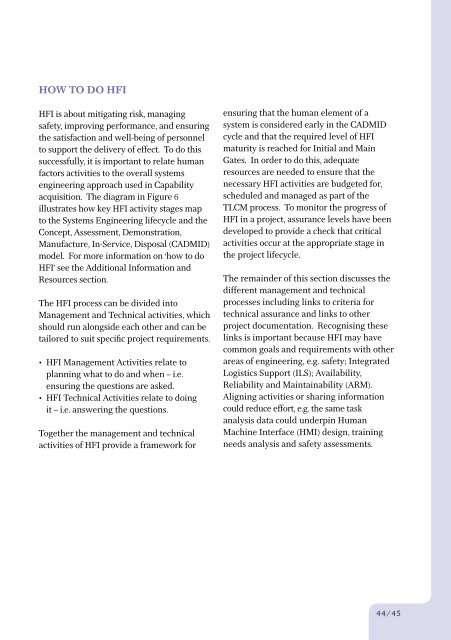The people in sysTems Tlcm handbook - Human Factors Integration ...
The people in sysTems Tlcm handbook - Human Factors Integration ...
The people in sysTems Tlcm handbook - Human Factors Integration ...
Create successful ePaper yourself
Turn your PDF publications into a flip-book with our unique Google optimized e-Paper software.
How to do HFI<br />
HFI is about mitigat<strong>in</strong>g risk, manag<strong>in</strong>g<br />
safety, improv<strong>in</strong>g performance, and ensur<strong>in</strong>g<br />
the satisfaction and well-be<strong>in</strong>g of personnel<br />
to support the delivery of effect. To do this<br />
successfully, it is important to relate human<br />
factors activities to the overall systems<br />
eng<strong>in</strong>eer<strong>in</strong>g approach used <strong>in</strong> Capability<br />
acquisition. <strong>The</strong> diagram <strong>in</strong> Figure 6<br />
illustrates how key HFI activity stages map<br />
to the Systems Eng<strong>in</strong>eer<strong>in</strong>g lifecycle and the<br />
Concept, Assessment, Demonstration,<br />
Manufacture, In-Service, Disposal (CADMID)<br />
model. For more <strong>in</strong>formation on ‘how to do<br />
HFI’ see the Additional Information and<br />
Resources section.<br />
<strong>The</strong> HFI process can be divided <strong>in</strong>to<br />
Management and Technical activities, which<br />
should run alongside each other and can be<br />
tailored to suit specific project requirements.<br />
• HFI Management Activities relate to<br />
plann<strong>in</strong>g what to do and when – i.e.<br />
ensur<strong>in</strong>g the questions are asked.<br />
• HFI Technical Activities relate to do<strong>in</strong>g<br />
it – i.e. answer<strong>in</strong>g the questions.<br />
Together the management and technical<br />
activities of HFI provide a framework for<br />
ensur<strong>in</strong>g that the human element of a<br />
system is considered early <strong>in</strong> the CADMID<br />
cycle and that the required level of HFI<br />
maturity is reached for Initial and Ma<strong>in</strong><br />
Gates. In order to do this, adequate<br />
resources are needed to ensure that the<br />
necessary HFI activities are budgeted for,<br />
scheduled and managed as part of the<br />
TLCM process. To monitor the progress of<br />
HFI <strong>in</strong> a project, assurance levels have been<br />
developed to provide a check that critical<br />
activities occur at the appropriate stage <strong>in</strong><br />
the project lifecycle.<br />
<strong>The</strong> rema<strong>in</strong>der of this section discusses the<br />
different management and technical<br />
processes <strong>in</strong>clud<strong>in</strong>g l<strong>in</strong>ks to criteria for<br />
technical assurance and l<strong>in</strong>ks to other<br />
project documentation. Recognis<strong>in</strong>g these<br />
l<strong>in</strong>ks is important because HFI may have<br />
common goals and requirements with other<br />
areas of eng<strong>in</strong>eer<strong>in</strong>g, e.g. safety; Integrated<br />
Logistics Support (ILS); Availability,<br />
Reliability and Ma<strong>in</strong>ta<strong>in</strong>ability (ARM).<br />
Align<strong>in</strong>g activities or shar<strong>in</strong>g <strong>in</strong>formation<br />
could reduce effort, e.g. the same task<br />
analysis data could underp<strong>in</strong> <strong>Human</strong><br />
Mach<strong>in</strong>e Interface (HMI) design, tra<strong>in</strong><strong>in</strong>g<br />
needs analysis and safety assessments.<br />
44/45

















